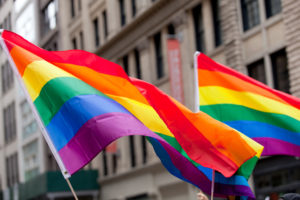 It’s June! You may see more rainbow flags this time of year as we celebrate Pride Month.
It’s June! You may see more rainbow flags this time of year as we celebrate Pride Month.
More therapists and counselors are becoming aware of issues the LGBTQIA (lesbian or gay, bisexual, transgender, queer and questioning, intersex, asexual and sometimes ally) community faces. But I would like to outline a few things that go deeper than using the right gender pronouns or supporting gay marriage. Yes, these steps are essential for those who would be supportive allies to LGBTQ people. But we, as providers of mental health and therapy services, must understand that being a supportive ally goes beyond these popular topics.
Topics to Consider
Equal marriage rights may have very little impact if the cycle of poverty prevents a person from knowing where their rent money, or even their next meal, is coming from. For trans women, especially women of color, who cannot find jobs due to racism and gender discrimination, dismantling systems of oppression may be far more important than legalizing gay marriage. If we truly hope to serve the LGBTQ+ community well, we must continue to push ourselves, embrace our discomfort and uncertainty, and listen more.
We must also learn to explore and recognize the intersection of sexuality, race, gender, class, and other identities. I contend that you cannot be a supportive ally to LGBTQ+ people without also learning to be an ally to people of color and other oppressed groups. Sexuality and race, sexuality and gender, sexuality and gender identity—these identities are not mutually exclusive. I would like to invite clinicians to continue to embrace this idea: If we are comfortable, we are not learning.
Another interesting topic to consider is the way trans theory sometimes bumps up against queer theory. Many transgender people find it important to embrace what may be considered traditional gender roles. Queer theory, on the other hand, may want to deconstruct the gender binary and embrace more of a continuum of gender. A trans friend of mine once expressed to me his ambiguity about attending his wife’s baby shower. “I don’t think men are supposed to go to those things,” he said. The queerness in me wanted to jump up and say, “WHAT?! That’s so traditional and sexist! It succumbs to the socially constructed gender binary that’s rooted in misogyny and patriarchy.” I write this sentence with some degree of humor because it is almost a caricature of a feminist activist quality. But that was the sentiment.
If we truly hope to serve the LGBTQ+ community well, we must continue to push ourselves, embrace our discomfort and uncertainty, and listen more.
After discussing this with some colleagues, I realized the embodiment of gender is really important for the trans community. To be able to express gender may be just as important as questioning the gender binary, even if that means embracing more traditional gender roles. As much as I am aware of the social construction of gender, I still want to embody what fits my gender identity. I am a cisgendered, fairly feminine queer person. I dye my hair blonde, wear skirts, and use makeup. These are ways I express my gender. Mental health professionals who want to serve people seeking help effectively must acknowledge the need for—and create—room for the technicolor of ways queer and trans people can be in the world. I encourage clinicians to be curious without being voyeuristic.
Simple visibility and bringing queerness into sessions are both also important. Do your intake forms ask about gender identity, pronouns, and sexuality? Or do you make assumptions? Do you use binary gender language like “male” or “female”? Doing so can marginalize LGBTQ+ people and prevent the therapy office from feeling like an affirming and safe place. I would say this really needs some attention in our work with children. Adult queer people who come to me for help processing trauma often have a memory of some kind of oppressive act related to their sexuality.
Do you think these memories date back to high school? Middle school? No. Traumatic memories around gender and sexuality are often from elementary school, even preschool. Bringing LGBTQ+ topics into children’s spaces is of great importance. When we go to do something at my son’s elementary school, we introduce ourselves as his moms. And I cannot tell you how many times a child, even a 12-year-old 6th grader, has said something like, “You can’t have two moms.”
We help our son find language to navigate these kind of interactions. But I cannot help but lament that so many children don’t know gay and trans people exist. My two children, aged 4 and 7, understand that gay and trans people exist. Talking about LGBTQ+ topics with children decreases bullying and fear. Discussing these topics can help children who are not LGBTQ+ learn about (and learn to accept!) people who are different. Children who are LGBTQ+ can learn that they are seen.
I want to encourage, most of all, for you to get uncomfortable. Watch an LGBTQ+ movie. Watch a documentary about the intersection of race, gender, and sexuality. Read something written by a queer person of color. Learn about the experience of an LGBTQ+ person. Above all, listen more and talk less.
Happy Pride!
© Copyright 2018 GoodTherapy.org. All rights reserved. Permission to publish granted by Erica Bonham, LPC, GoodTherapy.org Topic Expert
The preceding article was solely written by the author named above. Any views and opinions expressed are not necessarily shared by GoodTherapy.org. Questions or concerns about the preceding article can be directed to the author or posted as a comment below.

 Want to Help LGBTQ+ People? Don’t Be Glenda the Psychologist
Want to Help LGBTQ+ People? Don’t Be Glenda the Psychologist Transforming Vicarious Trauma in the LGBTQ+ Community
Transforming Vicarious Trauma in the LGBTQ+ Community How Embracing Uncertainty Can Help Transform LGBTQ+ Lives
How Embracing Uncertainty Can Help Transform LGBTQ+ Lives